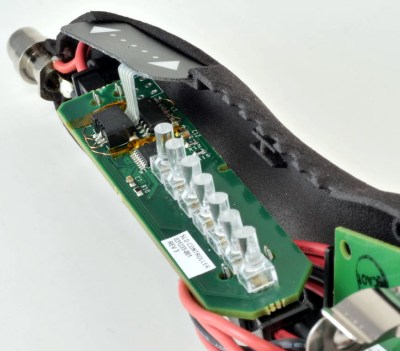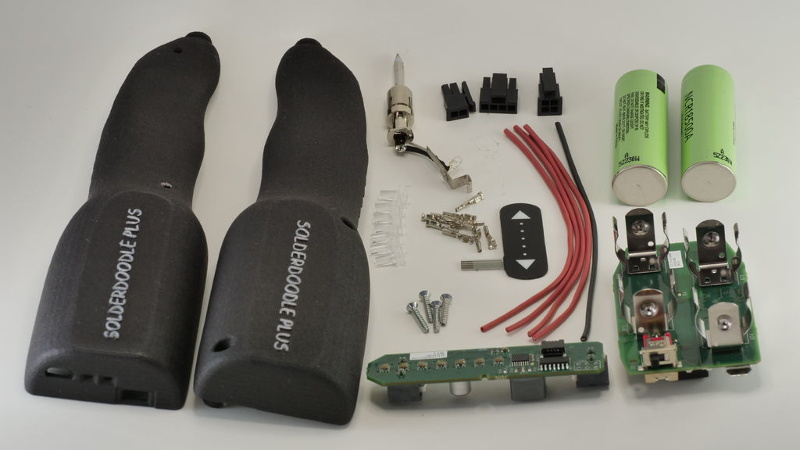Over the last year or so, cordless portable soldering irons have become all the rage. In fact, at this point a good number of Hackaday readers out there have likely traded in their full-size AC irons for a DC iron that’s only slightly larger than a pen. But before the big boom in portable irons, in the ye olden days of 2014, we brought you word of the open source Solderdoodle created by [Isaac Porras]. Based upon the Weller BP645 and featuring a 3D printed case, the DIY iron was designed to be charged from a standard USB port.
 Now, [Isaac] is back with an updated version he calls the Solderdoodle Plus. It’s still based on the heating element from the Weller BP645, but now boasts twice the power, an improved 3D printed case, an intuitive touch-based user interface, and even some LED blinkenlights for good measure. As with the original Solderdoodle the hardware and software for the device are open source and you’re invited to build your own, though kits are also available through an already fully-funded Kickstarter campaign.
Now, [Isaac] is back with an updated version he calls the Solderdoodle Plus. It’s still based on the heating element from the Weller BP645, but now boasts twice the power, an improved 3D printed case, an intuitive touch-based user interface, and even some LED blinkenlights for good measure. As with the original Solderdoodle the hardware and software for the device are open source and you’re invited to build your own, though kits are also available through an already fully-funded Kickstarter campaign.
[Isaac] says that the temperature control functions on traditional corded soldering irons waste energy due to the large thermal mass they have to bring up to temperature. But with less thermal mass and a system of variable duty cycle pulsed power, he says the Solderdoodle Plus can do the same work as an old-school 60 watt iron while only consuming 10 watts. This allows the iron to maintain a constant 500°C for over an hour on the dual internal Panasonic NCR18500A lithium-ion batteries, and means you can charge it up with nothing more exotic than a micro USB cable.
With the addition of new tips and its adjustable power level, the Solderdoodle Plus can also be used for other tasks where precise directed heat can be useful. In the video after the break, [Isaac] shows off a “scooper tip” and a low power setting on the iron which is specifically intended for cleaning up strings and imperfections on 3D printed parts without melting the part itself. If you dabble in the dead trees, there’s also a sharp tip which can be used for your pyrography projects.
Internally the Solderdoodle Plus features a custom charge controller based on the Maxim MAX8903G, and the control board is powered by an ATtiny84A microcontroller. It also makes use of the Interlink FSLP 34-00003, a turn-key touch sensor module, and some very slick Bivar VLP-350-F light pipes for the clever LED “bar graph” interface. Overall this isn’t something you’ll be building from what’s kicking around the parts bin, but all the information is available for you to spin up your own Solderdoodle Plus if you don’t mind sourcing all the parts and getting the boards made.
Since we brought you word of the original Solderdoodle, a lot of progress has been made in the world of portable irons. The TS100 has become a favorite of hackers the world over, which has naturally inspired some very impressive DIY clones, and you can even get USB powered irons for as little as $5 USD. The Solderdoodle Plus has some serious competition this time around, but we’re always happy to root for the open source underdog. Judging by the fact the Kickstarter was fully funded in less than 24 hours, it seems we aren’t alone.
















Looks really bulky. It’s also hella expensive for an inconvenient iron ($194 !).
That perception is probably why it took 5 kickstarters campaigns before it finally hit its funding goal.
Typical “portable” soldering irons with extra tips and external batteries are much more expensive, bulky, and lower quality than Solderdoodle Plus. Out of hundreds of original Solderdoodles shipped, practically all of them still work and hold a charge today.
Gaz soldering iron are compact, hold charge forever, powerful if needed, and pretty affordable: 70€ for a Portasol Pro.
If you need temp regulation for delicate work, then you better be on the bench with a real bench top soldering iron anyway.
If you do insist of having an electric portable, then go with the 50€ TS100 and a battery pack, at least you have full control, and not the dead weight of the battery in the handle.
Not sure what you mean by “full control”, the tips for other battery powered soldering irons are rather long like holding a pencil from the middle so you can’t get as close to the work. Also, temperature control wastes 5 to 6 times more energy controlling thermal mass temperature where Solderdoodle Plus just uses a lower duty cycle with a small thermal mass to achieve the same result while lasting longer with a smaller battery.
Man, this is clearly your preference. Tweepy is right as, I would choose gas or ts100. Mainly cause your design is weird. You should check previous professional solder designs like the hakko 907 on which everything is based for good reasons. Light and precise
I was thinking of the TS100 iron, for instance. I get that its quality, while surprisingly high, isn’t Metcal-high, it looks more convenient than the Solderdoodle. Why not design an iron with the TS100-ish form factor and external battery ?
Because there is a giant cord in your way. The whole point of portable is to get rid of the cord.
Still using IsoTip 7800’s
Still have my first one from late 70’s — still use it!
I used one when installing car audio when in high school (1979-1980). They were decent enough for what I was doing.
When I worked later for the Va State Police maintaining their system, we had butane soldering irons. Removing the tip made a mini-torch good for thawing out frozen locks at transmitter sites.
Car audio guys are now using Aussie Irons because of their 5 second heat up time and long battery life, but they are twice as expensive twice the size as Solderdoodle Plus.
Maybe the LEDs could also give a binary readout of the temperature?
(tongue in cheek)
I think my soldering experience would be fouled by having to look at comic sans every time I picked up my iron.
You realize the site you’re commenting on is called HACK a day, right? It’s an open hardware project, you can use any font you want, or no lettering at all, when printing the case.
But of course, then you’d have nothing to troll about.
hum – that thing looks amazingly bulky compared to say a TS-100 iron + 5S lipo battery pack. or alternatively the new Ts-80 with an USB-3 power bank.
The overall size of both variants would be larger but thanks to the Iron part being much smaller it would be more handy.
I’d love to see someone carrying a giant Li-Po pack with a 6-foot cable working inside their car or inside an assembled machine, because that’s not portable, you still have a giant cord. Solderdoodle Plus has no cord and heats up faster so you can quickly get in and out of your work area very conveniently and has no proprietary charger. You can also grip it with your thumb on the touch sensor if that’s more comfortable.
A 5s battery pack isn’t giant, or even very big. I could build a 120W 12Wh 5S pack that’s smaller than three inches cubed (6.5A 14500 cells, AKA AA sized, with 650mah of capacity) (IE, similar capacity to your unit), with exchangeable cells. If you can’t get a marker sized iron, with a few feet of cord, and a belt clipped battery pack, into a space, then you can’t get most other tools worth using in there, because your arm won’t fit.
On the plus side of your iron, you can plug it into a USB charger. On the other hand, I could use lithium cells that will directly charge themselves from Micro-usb in a pack for a TS100. But, the TS80 and TS100 have screens, so that you can set an actual temperature, and see what it is. That’s much better than just LED’s for an interface.
This is just a prototype too. As we speak, I’m in the process of refining the size, LED feedback, and ergonomics to fit even better. Temperature control is a bit overrated because you’re actually trying to get Watts delivered quickly to the surface, not temperature, and adjusting on the fly with a single finger is much faster especially if there’s different sized components, traces, ground planes, or wires in a single board or electrical assembly.
Hasn’t anyone noticed this thing could double it’s “usefulness” with some waterproofing and an exchange tip that is a small vibrating motor instead of a heating element?
The case, surely designed with ergonomics in mind, already looks like a Dildoodle…. ;-)
sorry – couldn’t resist.
This is so ridiculous its ridiculous. Really, if you guys buy in to this crap, you need you head examined. There is legitimately ZERO reason for this to exist. Actually, the reason fall well into the negative.
Amazing how much resistance there is for an all-in-one, lightweight, 5 second heat up, USB rechargeable soldering iron that runs on 10 Watts and can solder 12 gauge wire. There’s nothing that comes close to Solderdoodle Plus performance.
Probably because you seem unwilling to entertain any disagreement with your perceived superiority. Your iron may be capable, but its price point makes it hard to justify against legitimate alternatives whose reduction in portability you massively overstate.
I never overstate and I’m not superior. If there was a 10 Watt portable USB rechargeable cordless soldering iron under 150 grams that could solder 12 gauge wire with lead-free solder I would buy it, but it doesn’t exist so I invented Solderdoodle Plus to do that.
I don’t mean you are acting superior, just that you are determined to convince us that your iron is. Multiple times you have described cords that only need to carry ~40 Watts or less as huge.
That’s an awfully specific set of criteria. You’ve created an iron that fits exactly your demands. Does a portable soldering iron have to be 10 Watts to be good? Why not just use a butane iron? There are also plenty of people who would like to solder at a lower temperature than 500°C, e.g. those of us who still use leaded. I don’t think your iron is bad in any way, just that you overestimate its utility to the broader community.
Wow … there is so much negativity in these comments …
The designer obviously put a lot of time and effort into the project. And while this obviously won’t replace your Weller WXR station any time soon I guess that most naysayers would gladly put it to use if they had it on their workbench.